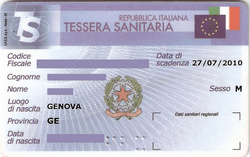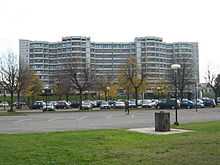Healthcare in Italy

For a general article on health in Italy, see health in Italy
Health care spending in Italy accounted for 9.0% of GDP in 2006 (about $2,600 per capita) of which about 75% is public,[1] slightly more than the average of 8.9% in OECD countries.[2] In 2000 Italy's healthcare system was regarded, by World Health Organization's ranking, as the 2nd best in the world after France,[3] and according to the CIA World factbook, Italy has the world's 6th highest life expectancy.[4] Thanks to its good healthcare system, the life expectancy at birth in Italy was 80.9 years in 2004, which is two years above the OECD average.[2]
History
After World War II Italy (re-)established its social security system including a social health insurance administered by sickness funds. In the 1970s the social health insurance faced several equity problems as coverage differed between the sickness funds and around seven percent of the population remained uninsured. Moreover, sickness funds went practically bankrupt by the mid-1970s. Due to growing public dissatisfaction with the existing healthcare system, Italian policymakers fostered a structural reform. In 1978, the government established the SSN (Servizio Sanitario Nazionale) — the Italian version of a National Health Service — including universal coverage and tax funding.[5]
National Health Service
.jpg)
Healthcare is provided to all citizens and residents by a mixed public-private system. The public part is the national health service (SSN) which is organized under the Ministry of Health and it's administered on a regional basis.
Family doctors are entirely paid by the SSN, must offer visiting time at least five days a week and have a limit of 1500 patients. Patients are assigned a doctor by the SSN but if they are dissatisfied with the assigned doctor they are free to change doctors, provided the doctor they choose has availability.
Prescription drugs can be acquired only if prescribed by a doctor. If prescribed by the family doctor, they are generally subsidized, requiring only a copay that depends on the medicine type and on the patient income (in many regions all the prescribed drugs are free for the poor). Over-the-counter drugs are paid out-of-pocket. Both prescription and over-the-counter drugs can only be sold in specialized shops (farmacia).
Visits by specialist doctors or diagnostic tests are provided by the public hospitals or by conventioned private ones, and if prescribed by the family doctor require only a copay (of the order of $40 for a visit without any diagnostic test) and are free for the poor. Waiting times are usually up to a few months in the big public facilities and up to a few weeks in the small conventioned private facilities. Patients, however, can opt for the "free market" option, provided by both public and private hospitals, which is paid completely out-of-pocket and has generally much shorter waiting times.
Surgeries and hospitalization provided by the public hospitals or by conventioned private ones are completely free of charge for everyone, regardless of the income. For the planned surgeries waiting times can be up to many months, especially in the big cities.
Emergency medicine
The emergency medical services in Italy currently consist primarily of a combination of volunteers and private companies providing ambulance service, supplemented by physicians and nurses who perform all Advanced Life Support procedures. The emergency telephone number for emergency medical service in Italy is 118. Emergency medical service is always free of charge. First aid is provided by all the public hospitals: for urgent cases it is completely free of charge for everyone (even for the undocumented), while a copay (about $35) is sometimes asked for non-urgent cases.
See also
References
- ↑ "World Health Organization - Italy". WHO. 2010.
- ↑ 2.0 2.1 "OECD Health Data 2008 How Does Italy Compare" (PDF). OECD. 2008.
- ↑ http://www.photius.com/rankings/healthranks.html
- ↑ https://www.cia.gov/library/publications/the-world-factbook/rankorder/2102rank.html
- ↑ http://www.sfb597.uni-bremen.de/pages/download.php?ID=190&SPRACHE=de&TABLE=AP&TYPE=PDF Frisina Doetter, Lorraine and Götze, Ralf (2011) "The Changing Role of the State in the Italian Healthcare System", TranState Working Papers No. 150
External links
- Italy - Information by World Health Organization
- Ministry of Health in Italy
| ||||||||||||||||||||||||||||||||||||||||||||
| ||||||||||||||
